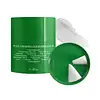What's inside
What's inside
 Key Ingredients
Key Ingredients

 Benefits
Benefits

 Concerns
Concerns

 Ingredients Side-by-side
Ingredients Side-by-side

Caprylic/Capric Triglyceride
MaskingC13-15 Alkane
SolventPEG-20 Glyceryl Triisostearate
EmollientSynthetic Wax
AbrasiveRicinus Communis Seed Oil
MaskingHelianthus Annuus Seed Oil
EmollientSilica Dimethyl Silylate
EmollientPolysorbate 85
EmulsifyingLithospermum Erythrorhizon Root Extract
Skin ConditioningPunica Granatum Fruit Extract
AntioxidantRibes Nigrum Fruit Extract
AstringentHippophae Rhamnoides Fruit Extract
Skin ConditioningFragaria Vesca Fruit Extract
AstringentMalpighia Emarginata Fruit Extract
Skin ConditioningEuterpe Oleracea Fruit Extract
Terminalia Ferdinandiana Fruit Extract
AntioxidantVaccinium Macrocarpon Fruit Powder
AntioxidantTrihydroxystearin
Skin ConditioningTocopheryl Acetate
AntioxidantZea Mays Germ Oil
EmollientPentaerythrityl Tetra-Di-T-Butyl Hydroxyhydrocinnamate
AntioxidantWater
Skin ConditioningButylene Glycol
HumectantCaprylic/Capric Triglyceride, C13-15 Alkane, PEG-20 Glyceryl Triisostearate, Synthetic Wax, Ricinus Communis Seed Oil, Helianthus Annuus Seed Oil, Silica Dimethyl Silylate, Polysorbate 85, Lithospermum Erythrorhizon Root Extract, Punica Granatum Fruit Extract, Ribes Nigrum Fruit Extract, Hippophae Rhamnoides Fruit Extract, Fragaria Vesca Fruit Extract, Malpighia Emarginata Fruit Extract, Euterpe Oleracea Fruit Extract, Terminalia Ferdinandiana Fruit Extract, Vaccinium Macrocarpon Fruit Powder, Trihydroxystearin, Tocopheryl Acetate, Zea Mays Germ Oil, Pentaerythrityl Tetra-Di-T-Butyl Hydroxyhydrocinnamate, Water, Butylene Glycol
 Reviews
Reviews

Ingredients Explained
These ingredients are found in both products.
Ingredients higher up in an ingredient list are typically present in a larger amount.
This ingredient is an emollient, solvent, and texture enhancer. It is considered a skin-softener by helping the skin prevent moisture loss.
It helps thicken a product's formula and makes it easier to spread by dissolving clumping compounds.
Caprylic Triglyceride is made by combining glycerin with coconut oil, forming a clear liquid.
While there is an assumption Caprylic Triglyceride can clog pores due to it being derived from coconut oil, there is no research supporting this.
Learn more about Caprylic/Capric TriglyceridePeg-20 Glyceryl Triisostearate comes from Isostearic Acid and glycerin.
It is an emollient, emulsifier, and gentle cleanser. As an emollient, it helps trap moisture to keep skin soft and hydrated. Emulsifiers help prevent ingredients from separating.
This ingredient is common in oil-based products. This is because it helps oil-ingredients be easily washed away without leaving a residue.
Peg-20 Glyceryl Triisostearate may not be fungal-acne safe.
Learn more about PEG-20 Glyceryl TriisostearateSynthetic Wax is created from fossil fuels such as natural gas. It is used to enhance texture, adjust pH, and as an occlusive.
It may also be used as an abrasive ingredient to exfoliate the skin.
Synthetic Wax may not be fungal acne safe.
Learn more about Synthetic WaxWater. It's the most common cosmetic ingredient of all. You'll usually see it at the top of ingredient lists, meaning that it makes up the largest part of the product.
So why is it so popular? Water most often acts as a solvent - this means that it helps dissolve other ingredients into the formulation.
You'll also recognize water as that liquid we all need to stay alive. If you see this, drink a glass of water. Stay hydrated!
Learn more about Water